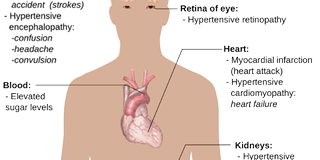Society needs a constant reminder

An illustration showing the complication of one of the lifestyle disease, hypertension. Photo | Pixabay
What you need to know:
Non-communicable diseases kills about 40 million people each year.
Today’s world revolves around extreme tobacco use, physical inactivity, alcohol abuse and unhealthy diets, all of which contribute to grave conditions called Non communicable diseases (NCDs). There is need to constantly remind the society on how to prevent such diseases.
At present, NCDs occur to be the world’s most prevalent cause of death and disease burden worldwide, according to the World Health Organisation (WHO).
WHO says NCDs kills about 40 million people each year, equivalent to 70 per cent of all deaths globally. Thirty-eight million people die each year from NCDs, mainly from cardiovascular diseases, cancers, chronic respiratory diseases, and diabetes.
Over 14 million deaths from NCDs occur between the ages of 30 and 70, of which 85 per cent are in developing countries, hence the urgency of addressing it.
NCDs are chronic in nature and this has a huge impact on the economy of people who suffer from the diseases because they require long-term medical care.
Diseases such as hypertension, diabetes, cancers and lung diseases like asthma and bronchitis are among the main types of NCDs.
They are often associated with older age groups, mostly between the ages of 30 and 69 years.
A closer look at high blood pressure
Also known as hypertension, is one of the key challenges here and I will explore it at length.
First, it is important to understand that blood pressure is the force exerted by blood against the walls of blood vessels.
How great the pressure is, depends on the work being done by the heart and the resistance to blood flow in the arteries.
The more blood your heart pumps and the narrower your arteries, the higher your blood pressure. Hypertension, therefore can be defined as blood pressure higher than 140 over 90 millimeters of mercury (mmHg).
Most people with high blood pressure have no signs or symptoms, even if blood pressure readings reach at dangerously high levels.
A few people with high blood pressure may have headaches, shortness of breath or nosebleeds, but these signs and symptoms are not specific and usually do not occur until high blood pressure has reached a severe or life-threatening stage.
However, even without symptoms, damage to blood vessels and the heart continues! Uncontrolled high blood pressure increases the risk of serious health problems, including heart attack and stroke.
“Prevention is better than cure” - If we lessen the global impact of risk factors, we can go a long way to decreasing the number of deaths worldwide.
The author is a medical student at Hubert Kairuki Memorial University


